Japanese Embroidery: The Techniques Based on Nuido is the “beginner’s guide” to Japanese embroidery, published by the Japanese Embroidery Center in Atlanta, Georgia.
Even if Japanese embroidery isn’t your thing, this is a book that you’ll find very useful. I’ve had the print version for a while, and I’ve learned a lot from it!
The JEC has recently released Japanese Embroidery in a digital version, available at an affordable price. Compared to the $42 price tag for the print version, the digital version is $19. And if you happen to live outside the US, where postage can be prohibitive when ordering books, you can readily see the advantages of a digital edition.
Yesterday, I purchased and downloaded the digital version so that I could give you a balanced review.
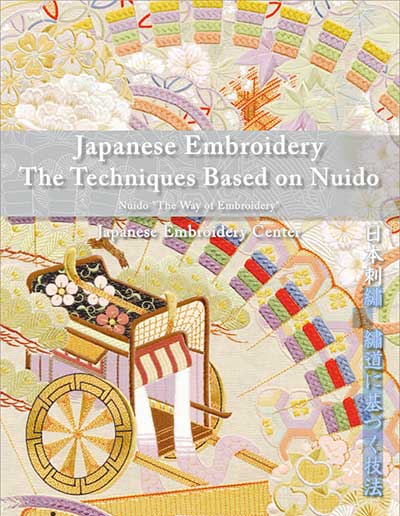
Why do I think you can benefit from this book, even if you aren’t really into Japanese embroidery?
Japanese embroidery consists of working with flat silk and with Japanese gold and silver threads. If you want tips for working with both of these mediums, a good book on Japanese embroidery can be quite helpful.
There are other advantages, though. For example, the Japanese embroidery frame can be a useful tool for any kind of serious surface embroidery like goldwork, silk work, or larger projects that need a really taut, stable surface. In Japanese embroidery books like this one, you’ll find information on how to set up and use a Japanese embroidery frame.
And finally – and most importantly – the different filling and stitching techniques, padding techniques, and finishing techniques can all readily translate into regular surface embroidery.
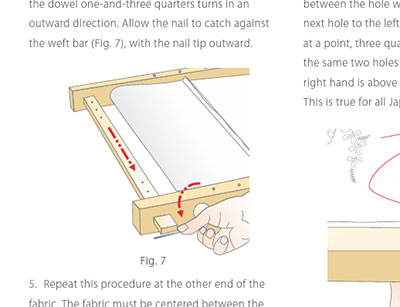
So, what will you find in the book? It’s divided into two sections: Equipment and Methods, and The Stitches of Japanese Embroidery.
In the first section, you’ll find information on the fabrics used in Japanese embroidery (with descriptions), on special equipment (like the koma and tekobari), details on the frame and how to set it up, instructions on twisting the flat Japanese silks into twisted silks, guidance on working with Japanese gold and silver threads, general notes on working the embroidery, and directions on the finishing process.
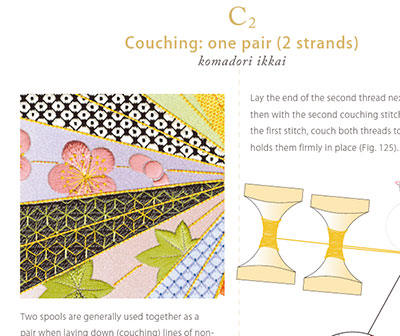
Anything that requires visual instruction for clarification is presented with clear diagrams and drawings.
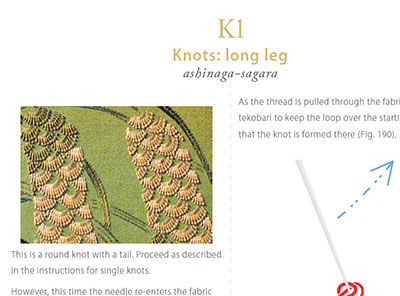
In the second section of the book, we are introduced to the stitches of Japanese embroidery. Each stitch is accompanied by a clear photo of the stitch, embroidered, and diagrams on working the stitch.
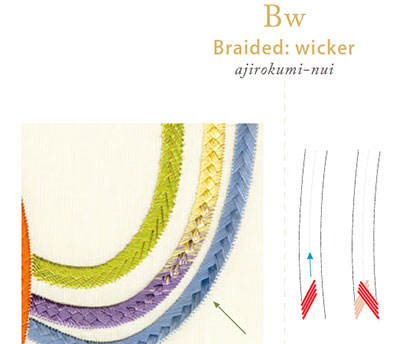
Compared to some stitch instruction books, the approach here is somewhat minimalistic, but still clear and logical. The diagrams and the accompanying text are easy to follow and understand.
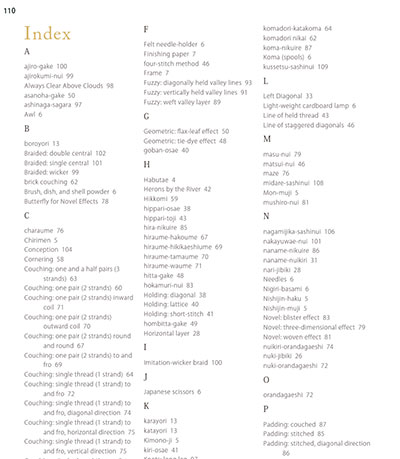
The book is over 100 pages, and, to make it easy to get around in the digital version, there’s an excellent index in the back with clickable terms, so you can look up any term, click on the associated page numbers, and end up right at that point in the book.
A Note on the Download Process
I’m a fairly computer literate person, so I found the download process easy enough. But you should be warned that you need specific software (Adobe Digital Editions) to open the book. This software is free, but if you don’t know how to go about downloading and installing software, you might have to ask a computer savvy friend to help you out.
You’ll find information on the digital download process on the product page for Japanese Embroidery. Scroll to the end of the page, under the order information, and read that stuff thoroughly before you purchase, so that you don’t purchase the book without knowing what you’re getting into!
I only bring this part up because I know that some folks might not be computer-oriented, and if that describes you, you may need to line up a family member or a buddy to help you through the process. That being said, the JEC does have a PDF available on the product page to take you step-by-step through the whole software and download process.
Overall, Japanese Embroidery: The Techniques Based on Nuido is an excellent book for your needlework library, and the digital edition makes it very convenient and affordable to have access to a copy!







Dear Mary
Japanese Embroidery sounds a good instructional book with lots of good advice on this intricate embroidery. I like the idea of the koma and tekobari instructions and the photo and diagram of the stitches. The clickable index pages are always useful when you want to glance at something specific. All in all this sounds a good resource for all kinds of embroidery thanks for sharing this especially on how to download the book.
Regards Anita Simmance
Thanks for another great review. In your opinion, does this cover material that Techniques of Japanese Embroidery doesn’t? For me, the information about using the frames might well be worth the price of admission as I’ve recently come up against the limitations of hoops…even great ones, but wondered how the stitch dictionary compared.
The book looks beautiful based on when is shown.
Mary
I was told that Japanese embroidery was very difficult to achieve, it may be experienced embroiderers to address, but the digital book is tempting to have for a new experience and discovery. I do not feel ready yet.
Thank you for the discovery Marie
As with any other embroidery it just takes practice. When you take a class you discover that, as with many other Japanese crafts, there are specific rules as to how to do things. I had one instructor say that it was easier from teach a complete novice stitcher as they had fewer habits to unlearn. I don’t know how easy it would be to learn from a book but the books have gotten much better since I started. There are also classes available throughout this country, Canada,Europe., Australia and New Zealand.
Ooh, thanks for taking us to Japan this morning, Mary! What wonderful times we live in to have this information available so easily in English! If I were not up for doing the embroidery, myself, at least I could better appreciate the work when I see it. I have collected beautiful embroidery while traveling and in thrift shops. As for downloading, I am struggling with an “elderly” computer. It’s a constant learning curve and need to keep the hardware current as well. The good news is that a decent laptop goes for as little as $300 now, so there’s hope.
Thank you Karen
I also think it would be difficult to learn from a book the japanese embroidery, and yes we can make bad postures when we learn only. I hope to receive an education in the future in France. So I wait. But I taught myself with books quite technical especially those written in French because the language barrier is often a barrier, but fortunately for all of us and I were Marie and I use machine translation with sometimes giggles …
I lost a sweet Japanese friend this last year. Akiko had gone to university here. Her English was better than mine. Her color sensibility was very different. I would listen to her color philosophy about kimono and just modern fashion. Japanese knitting is as upside down and backwards as their writing — compared to American, that is. Years ago Akiko paid me to finish a pullover she started — in Japanese! The subtle truths Mary shares here can hardly be conveyed through machine translation. Ideas of gently or smoothly or the “hand” of a fabric would be lost in machine translation. So we nibble at subjects we want to learn. Then comes a book in English — or a new friend from that country who speaks English — or a trip to that country . . .
This sounds great Mary, and I would love to have the book. I have the Adobe thing but our download speed is very slow (comes of living in country Australia – apparently we don’t count when it comes to dishing out access to high-speed data etc. Do you know if this is going to be problematic? The reason I ask is that some things download very quickly but others take forever.
Hi, Christina – the initial download is a code that you put in Adobe Digital Editions, and that generates the file. It’s not a PDF to be read by Adobe Acrobat. Once the file is generated in the software, it works readily, and the whole process was pretty quick. -MC
Dear Mary,
Do you know if this still requires ADE? They have a new process but I don’t exactly understand it. Are you actually buying a copy of the book or are you buying access to an online copy? Could you use it without an internet connection, for example? (Once downloaded, obviously.) Either way, does it require anything Adobe? (Plugin or standalone programme?)
I thought you would know if you’d ‘transferred’ your copy of the ebook to the new site. (Which suggests you never actually have a copy – if the site disappears, there goes your book?)
Just rather confused (and not at all sure you read comments on posts this old!).
You might contact them directly for technical questions.